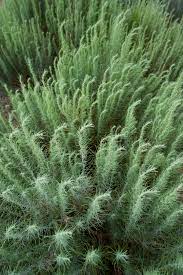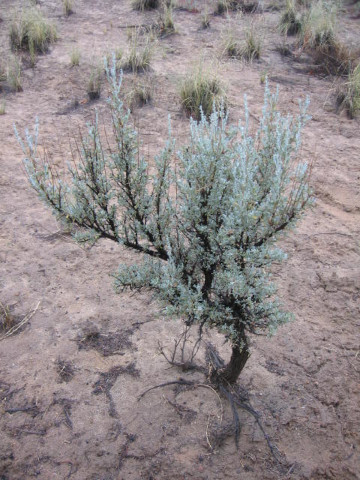This hideous growth, which is to weary our eyes as far as central valleys of the Sierra Nevada, will require a few words of notice. The artemisia, absinthe, or wild sage differs much from the panacea concerning which the Salernitan school rhymed:
"Cur moriatur homo cui Salvia crescit in horto.”
Yet it fills the air with a smell that caricatures the odor of the garden-plant, causing the traveler to look round in astonishment; and when used for cooking it taints the food with a taste between camphor and turpentine. It is of two kinds.  The smaller or white species (A. filifolia) rarely grows higher than a foot. Its fetor is less rank, and at times of scarcity it forms tolerable fodder for animals. The Western men have made of it, as of the “red root,” a tea, which must be pronounced decidedly inferior to corn coffee. The Indians smoke it, but they are not particular about what they inhale: like that perverse p- n of Ludlow, who smoked the bell-ropes rather than not smoke at all, or like school-boys who break themselves in upon ratan, they use even the larger sage as well as a variety of other graveolent growths.
The smaller or white species (A. filifolia) rarely grows higher than a foot. Its fetor is less rank, and at times of scarcity it forms tolerable fodder for animals. The Western men have made of it, as of the “red root,” a tea, which must be pronounced decidedly inferior to corn coffee. The Indians smoke it, but they are not particular about what they inhale: like that perverse p- n of Ludlow, who smoked the bell-ropes rather than not smoke at all, or like school-boys who break themselves in upon ratan, they use even the larger sage as well as a variety of other graveolent growths.  The second kind (A. tridentata) is to the family of shrubs what the prairie-cedar is to the trees—a gnarled, crooked, rough-barked deformity. It has no pretensions to beauty except in earliest youth, and in the dewy hours when the breeze turns up its leaves that glitter like silver in the sun, and its constant presence in the worst and most desert tracts teaches one to regard it, like the mangrove in Asia and Africa, with aversion. In size it greatly varies; in some places it is but little larger than the white species; near the Red Buttes its woody stem often attains the height of a man and the thickness of his waist. As many as fifty rings have been counted in one wood, which, according to the normal caiculation, would bring its age up to half a century. After its first year, stock will eat it only when threatened with starvation. It has, however, its use; the traveler, despite its ugliness, hails the appearance of its stiff, wiry clumps at the evening halt: it is easily uprooted, and by virtue of its essential oil it makes a hot and lasting fire, and ashes over. According to Colonel Frémont, “it has a small fly accompanying it through every change of elevation and latitude.” The same eminent authority also suggests that the respiration of air so highly impregnated with aromatic. plants may partly account for the favorable effect of the climate upon consumption.
The second kind (A. tridentata) is to the family of shrubs what the prairie-cedar is to the trees—a gnarled, crooked, rough-barked deformity. It has no pretensions to beauty except in earliest youth, and in the dewy hours when the breeze turns up its leaves that glitter like silver in the sun, and its constant presence in the worst and most desert tracts teaches one to regard it, like the mangrove in Asia and Africa, with aversion. In size it greatly varies; in some places it is but little larger than the white species; near the Red Buttes its woody stem often attains the height of a man and the thickness of his waist. As many as fifty rings have been counted in one wood, which, according to the normal caiculation, would bring its age up to half a century. After its first year, stock will eat it only when threatened with starvation. It has, however, its use; the traveler, despite its ugliness, hails the appearance of its stiff, wiry clumps at the evening halt: it is easily uprooted, and by virtue of its essential oil it makes a hot and lasting fire, and ashes over. According to Colonel Frémont, “it has a small fly accompanying it through every change of elevation and latitude.” The same eminent authority also suggests that the respiration of air so highly impregnated with aromatic. plants may partly account for the favorable effect of the climate upon consumption.
(The City of the Saints) [page 53-4]